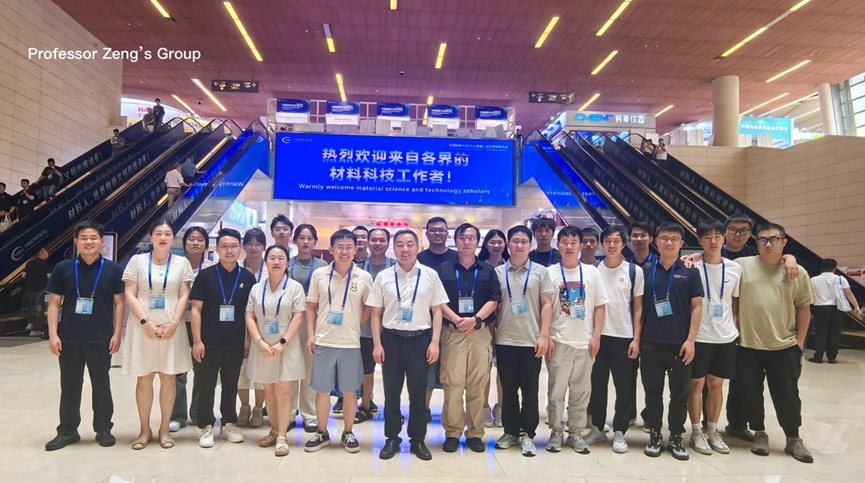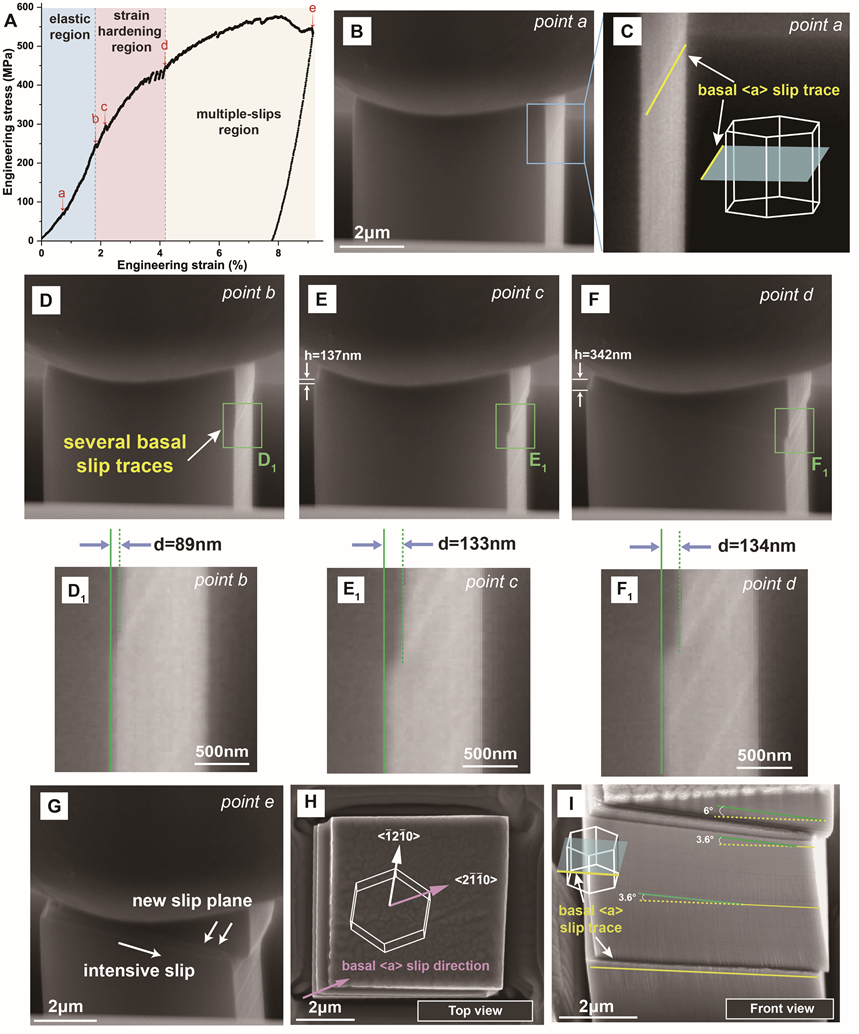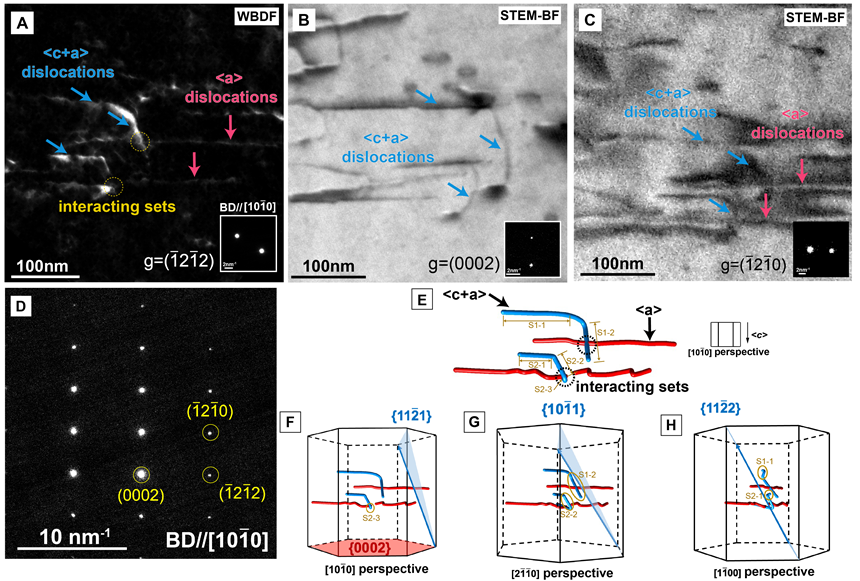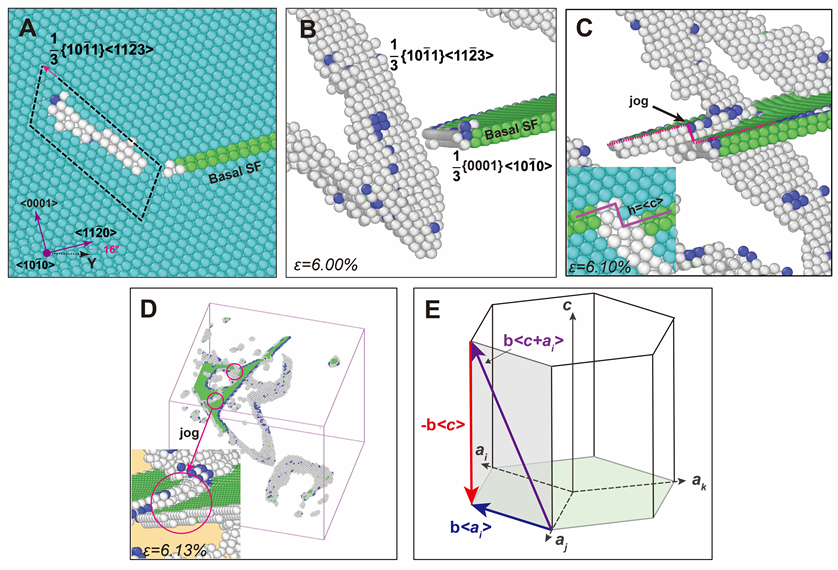Recently, Prof. Xiaoqin Zeng’s group from the School of Materials Science and Engineering of Shanghai Jiao Tong University has made significant progress in research on enhancing the strength and toughness of magnesium alloys through multi-slip systems. They innovatively proposed and validated a novel strategy to significantly improve the material's strain hardening capability and ductility by tuning the interactions between dislocations from different slip systems (basal <a> dislocations and pyramidal <c+a> dislocations) within the magnesium alloy. This provides a new theoretical basis and feasible pathway for designing the next generation of magnesium alloys with both high strength and high ductility. The related results, titled "Anomalous strain hardening via manipulating basal/pyramidal dislocation interactions in the Mg-Y-Ca alloy," were published in the internationally renowned academic journal Acta Materialia (https://doi.org/10.1016/j.actamat.2025.121309).

Professor Zeng Xiaoqin Zeng and Professor Jingya Wang from Shanghai Jiao Tong University, and Professor Boyu liu from Xi’an Jiao Tong University are the co-corresponding authors. Mingdi Yu, a Ph.D. student at Shanghai Jiao Tong University (recipient of the 2023 National Scholarship for Ph.D. Students and the 2024 Shanghai Jiao Tong University Outstanding Doctoral Graduate Development Scholarship), is the first author. The research was supported by the National Natural Science Foundation of China (Grant Nos.: 52471012, 52425101, 52371121, 52471013 and U2241245), the Comunidad de Madrid, Recovery, Transformation and Resilience Plan, and the MAD2D project funded by the EU NextGenerationEU fund.

The quest for materials with superior mechanical properties (high strength and high ductility) has always been a fundamental research topic in the field of physical metallurgy. However, achieving both high strength and high ductility in materials has long been a key challenge. In general, high strength is attained by impeding dislocation movement through grain boundaries, solute atoms and precipitates. In contrast, superior ductility is always associated with the material’s ability of strain hardening, which originates from the continuous nucleation, movement, accumulation of dislocations and their interactions. Consequently, it is difficult to design metallic alloys that simultaneously behaves high strength and high ductility and often one of them has to be sacrificed in benefit of the second, leading to the so-called strength-ductility trade-off. This dilemma especially arises in the lightest structural metal, magnesium, which restricts its broader use in structural applications.
The plastic deformation of traditional magnesium relies heavily on basal slip, leading to few dislocation interactions, low flow stress, easy localization of deformation, and ultimately resulting in low plasticity (pure Magnesium tensile fracture elongation is often <5%) and the strength-plasticity trade-off dilemma. Although promoting pyramidal <c+a> slip through alloying is a common strategy to enhance plasticity, the dominance of basal slip during plastic deformation and the resulting localized "avalanche" effect remain difficult to effectively suppress. Therefore, to overcome the strength-plasticity trade-off in magnesium, it is essential to suppress basal <a> dislocation slip while promoting pyramidal <c+a> dislocation glide to increase the probability of dislocation interactions, thereby hindering the localization of basal slip and triggering strain hardening.
Professor Zeng’s group has long been dedicated to research on the microscopic mechanisms of plastic deformation and the high-performance design of magnesium alloys. Previously, by tuning the difference in slip system activation capability through adding solute elements, they proposed the academic concept of "synergistic ductility enhancement via multi-slip systems" (related results published in IJP, 2023, https://doi.org/10.1016/j.ijplas.2023.103525; ACTA, 2021, https://doi.org/10.1016/j.actamat.2021.117151; Acta Metallurgica Sinica, 2025, https://doi.org/10.11900%2F0412.1961.2024.00358). Building on this foundation, using the Mg-Y-Ca alloy, which can synergistically activate multiple slip systems for plastic deformation, as a model system, and combining techniques such as single-crystal in-situ micropillar compression tests, EBSD/TKD characterization, TEM 3D reconstruction, and molecular dynamics simulations, they precisely analyzed and actively designed key dislocation interaction behaviors for the first time. They proposed design criteria for promoting effective dislocation interactions to enhance strain hardening, providing a new strategy for designing novel high-strength-high-ductility magnesium alloys.
The study found: Under specific single-crystal loading conditions, the interaction between basal <a> dislocations and pyramidal <c+a> dislocations can form "sessile jogs" structures possessing a pure <c> component. This structure acts like a "powerful roadblock" on the dislocation slip path, effectively hindering the rapid slip and continuous movement of basal dislocations. This key mechanism significantly alleviates the tendency for plastic deformation to localize within basal slip bands, endowing the material with a strong strain hardening capability. The continuously increasing flow stress further promotes the activation of more non-basal <c+a> dislocations, forming a virtuous cycle, thereby significantly enhancing the strain hardening capability (UTS−YS = 96 MPa) and plasticity (elongation ≈31%) of the single-phase solid solution Mg-Y-Ca alloy. This research not only reveals for the first time the specific microscopic mechanism for achieving "anomalous" strong strain hardening in magnesium alloys by manipulating interactions between specific types of dislocations (basal and pyramidal dislocations), but also proposes a new design criterion for overcoming the strength-plasticity trade-off in magnesium alloys: The key lies in promoting effective dislocation interactions (especially between basal and pyramidal dislocations), rather than simply reducing the activation difficulty of non-basal slip. This profound understanding lays a solid scientific foundation for the future design of high-performance magnesium alloys with novel deformation mechanisms and simultaneous enhancement of strength and plasticity, through precise regulation of alloy composition and microstructure.

Fig. 1. (A) Schmid factor for basal <a>, pyramidal I <c+a> and pyramidal II <c+a> slips in HCP Mg. (B) IPF mapping in Mg-Y-Ca alloy containing the target grain for micropillar compression and the different view direction of the micropillar. (C) Right view of the micropillar crystalline orientation and the angle α between the perspective of camera in SEM and the surface of bulk sample.

Fig. 2. (A) Engineering stress-strain curve of the deformed micropillar. (B-F) Images of the deformed micropillar at different stages of deformation marked by points a to d, as indicated in (A), taken from in-situ compression movie. (D1-F1) Enlarged areas from the green square regions in (D-F). (G) The snapshot of deformation region: point e taken from in-situ compression movie of the micropillar. SEM images of the compressed micropillar from the view of (H) top and (I) front sides and the corresponding illustrations of crystal structure for the compressed micropillar from the front view.

Fig. 3. Weak beam dark field (WBDF) micrographs of the thin lamella of the deformed micropillar with g =. (B-C) STEM-Bright field (STEM-BF) TEM micrographs were used to investigate the same area in A with g = (0002) and g =
 , respectively. (D) Selected area electron diffraction (SAED) pattern with the beam direction along
, respectively. (D) Selected area electron diffraction (SAED) pattern with the beam direction along  direction of this lamella. (E) The interaction of basal <a> and pyramidal <c+a> dislocations was shown along
direction of this lamella. (E) The interaction of basal <a> and pyramidal <c+a> dislocations was shown along  orientations. Two curvilinear <c+a> dislocations were selected for 3D analyses. Each <c+a> dislocation was divided into different segments (S1-1, S1-2, S2-1, S2-2 and S2-3). (F)-(H) Viewing directions are
orientations. Two curvilinear <c+a> dislocations were selected for 3D analyses. Each <c+a> dislocation was divided into different segments (S1-1, S1-2, S2-1, S2-2 and S2-3). (F)-(H) Viewing directions are  ,
,  and
and  , respectively. 3D reconstruction revealing the basal and pyramidal gliding planes of <a> and <c+a> dislocations.
, respectively. 3D reconstruction revealing the basal and pyramidal gliding planes of <a> and <c+a> dislocations.

Fig 4. (A, B) Local atomic structures showing basal <a> and the pyramidal <c+a> dislocations; (C) Jog formation during the interaction between basal <a> and pyramidal <c+a> dislocations. (D) Hindering of basal <a> dislocation slip by the sessile jogs formed during interaction. (E) Illustration of the reaction between basal <a> and pyramidal <c+a> dislocations.

Fig. 5. (A) Comparison of the elongation and UTS−YS values of different solid solution magnesium wrought alloys. Detailed data are listed in Table 2. (B) Stress required to activate basal <a> and pyramidal <c+a> slip systems in Mg-Y-Ca alloy and pure Mg as a function of ![]() angle between the c-axis and the compression direction of the micropillar.
angle between the c-axis and the compression direction of the micropillar.
